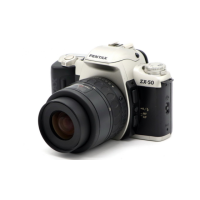
Do you have a question about the Pentax ZX-50 and is the answer not in the manual?
| Film Format | 35mm |
|---|---|
| Flash Sync Speed | 1/100 sec |
| Battery | 2 x CR2 |
| Shutter Speed | 30 - 1/2000 sec |
| Metering | TTL |
| Exposure Modes | Program, Aperture Priority, Shutter Priority, Manual |
| Metering System | 6-segment TTL |
| Flash | Built-in |
| ISO Range | 25 - 5000 |
| Focus | Automatic/Manual |
This mark indicates precautions that, if not followed, could result in serious injury to the operator.
This mark indicates precautions that, if not followed, could result in minor or medium injury to the operator or damage to the equipment.
Focus on the subject which is not in the center of the viewfinder. Changing the in-focus range.
Taking a picture in low light situations. Minimizing the red-eye effect. Automatic Flash Functions.
Making a picture larger or smaller. Changing the in-focus range.
Taking a picture with the desired exposure setting. Taking a picture in strong backlit situations with the main subject in the shadow.
Putting yourself into a picture. Taking a group photograph. Taking a portrait photograph.
Taking a picture of night scenery. Taking a picture of people with night scenery in the background.
Imprinting the data on a picture. Taking a picture of a moving subject. Taking a close-up picture of flower.
Indicates the camera is in Metered Manual Mode.
Displays the manual film speed setting.
Indicates the set shutter speed.
Indicates the set aperture value.
Indicates the exposure compensation setting.
Indicates the red-eye reduction flash is active.
Indicates the automatic flash function is active.
Indicates the autofocus frame in the viewfinder.
Indicates the set shutter speed.
Indicates the set aperture value.
Provides information about the flash status.
Indicates when the subject is in focus.
Indicates the exposure compensation setting.
Displays the exposure level or compensation.
Instructions for opening the battery chamber and loading batteries.
Steps for aligning red indexes and attaching the lens.
Guide for sliding the main switch to the ON position.
How to hold the camera and turn the aperture ring to the A position.
Instructions for setting the mode dial to the desired position.
Instructions for fitting the strap onto the camera as illustrated.
Steps for opening the battery chamber and loading batteries.
Aligning red dots on the camera and lens, then turning the lens to attach.
Explains the two positions of the shutter release button and their functions.
Instructions for turning the camera power ON by moving the main switch.
Information on how the DATE model records data on photographs.
Steps for opening the back cover, placing the film cartridge, and closing the cover.
Explains automatic film rewinding at the end of the roll and manual rewinding.
For easy picture taking, use Green Operation Mode for automatic exposure settings.
Sets the drive mode switch to the single-frame position for one picture at a time.
Explains how to use the zoom function to make subjects appear larger or smaller.
Demonstrates how to hold the camera horizontally and vertically for stable shots.
Instructions for setting the focus mode switch to AF for automatic focusing.
Steps for focusing on the subject and depressing the shutter release button fully.
Purpose and method for using focus lock to maintain focus on a subject.
Information on the flash-recommended indicator and using the built-in flash.
Explains the red-eye reduction flash function and how it works.
Details on the automatic flash function for low light or backlit conditions.
Details on Single-Frame, Consecutive-Frame, and Self-timer modes.
Steps for setting the focus mode to MF and using the focusing ring.
Guide to selecting Picture Modes like Green, Portrait, Landscape, Close-up, Action.
For easy picture taking, use Green Operation Mode for automatic exposure settings.
This mode is suitable for taking portrait photography.
This mode is ideal for landscape photography and scenic snapshots.
This mode favors smaller apertures to maximize depth of field for close-up subjects.
This mode selects a faster shutter speed to capture a moving subject.
Instructions for selecting exposure modes like Shutter-Priority AE, Metered Manual, Bulb.
Purpose and steps for using Aperture-Priority AE mode for shooting landscapes or portraits.
Guide to using Metered Manual Mode for creative control over shutter speed and aperture.
Useful for long exposures required for shooting night scenes and fireworks.
Explains how to use exposure compensation for brighter or darker exposures.
Instructions on how to turn off the audible In-Focus PCV signal.
Details on using the built-in flash in different exposure modes.
Steps for manually setting the film speed (ISO) when using non-DX coded film.
Instructions for installing the battery in the data back unit.
Guide for adjusting the year, month, day, hour, and minute on the date back.
Instructions for using TTL auto flash mode with dedicated external flashes.
Techniques for daylight-sync photography to eliminate subject shadows.
How to balance foreground and background exposure for slow-sync flash shots.
Lists and describes optional accessories like flash units, cable switches, and magnifiers.
Information on available camera cases and their applicable lens types.
Illustrates how aperture and shutter speed affect image appearance and motion.
Explains depth of field and how it relates to aperture and focal length.
Guide for using the infrared index for focusing with infrared filters.
Lists common camera problems, their causes, and remedies with page references.
Technical specifications of the camera, including type, usage, and dimensions.